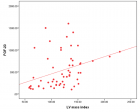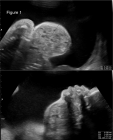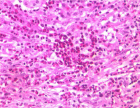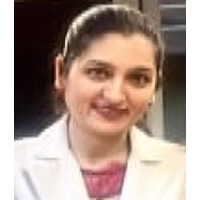Abstract
Retrospective Study
Tracheotomy in Severe Head Trauma: Early vs. Late
Nada Benabdelouahab*, Hajar Moujtahid, Larbi Aberouch, Jaouad Tadili, Ali Kettani and Mamoun Faroudy
Published: 19 January, 2024 | Volume 9 - Issue 1 | Pages: 001-004
Introduction: The evolution of a patient with severe traumatic brain injury may require the use of a tracheostomy as part of respiratory weaning. The central question revolves around the optimal timing to replace intubation with tracheostomy. The aim of this study is to evaluate the hypothesis that early tracheostomy reduces the incidence of ventilator-associated pneumonia (VAP), the duration of mechanical ventilation (MV), and the length of stay in the intensive care unit (ICU).
Materials and methods: This was a retrospective study including all patients admitted to the department over a period of 08 months. Various historical, demographic, clinical, biological, and progression-related covariates were collected upon admission.
Results: Among the 69 patients included in the study who underwent surgical tracheostomy,
two groups were formed: those who underwent early tracheostomy (within the first 8 days of mechanical ventilation) and those with late tracheostomy (after 8 days). The early group showed a significant reduction in the duration of mechanical ventilation (16 ± 3 days) and length of stay in the intensive care unit (17 ± 3 days) compared to the late group (23 ± 6 days and 30 ± 11 days, respectively). No significant differences were observed regarding the incidence of ventilator-associated pneumonia (VAP) and mortality between the two groups.
Conclusion: This study strengthens the existing literature by demonstrating that early tracheostomy is associated with a reduction in the duration of MV and length of stay in the ICU.
Read Full Article HTML DOI: 10.29328/journal.jcicm.1001045 Cite this Article Read Full Article PDF
Keywords:
Tracheotomy; Head trauma; Pneumonia; Mortality; Resuscitation
References
- Management of serious head injuries in the early phase. Recommendations for clinical practice. What are the indications and methods of mechanical ventilation? Ann Fr Anesth Réanim 1999;18:72–8.
- Roquilly A, Cinotti R, Jaber S, Vourc'h M, Pengam F, Mahe PJ, Lakhal K, Demeure Dit Latte D, Rondeau N, Loutrel O, Paulus J, Rozec B, Blanloeil Y, Vibet MA, Sebille V, Feuillet F, Asehnoune K. Implementation of an evidence-based extubation readiness bundle in 499 brain-injured patients. a before-after evaluation of a quality improvement project. Am J Respir Crit Care Med. 2013 Oct 15;188(8):958-66. doi: 10.1164/rccm.201301-0116OC. PMID: 23927561.
- Vallverdú I, Calaf N, Subirana M, Net A, Benito S, Mancebo J. Clinical characteristics, respiratory functional parameters, and outcome of a two-hour T-piece trial in patients weaning from mechanical ventilation. Am J Respir Crit Care Med. 1998 Dec;158(6):1855-62. doi: 10.1164/ajrccm.158.6.9712135. PMID: 9847278.
- Rothaar RC, Epstein SK. Extubation failure: magnitude of the problem, impact on outcomes, and prevention. Curr Opin Crit Care. 2003 Feb;9(1):59-66. doi: 10.1097/00075198-200302000-00011. PMID: 12548031.
- Esteban A, Alía I, Gordo F, Fernández R, Solsona JF, Vallverdú I, Macías S, Allegue JM, Blanco J, Carriedo D, León M, de la Cal MA, Taboada F, Gonzalez de Velasco J, Palazón E, Carrizosa F, Tomás R, Suarez J, Goldwasser RS. Extubation outcome after spontaneous breathing trials with T-tube or pressure support ventilation. The Spanish Lung Failure Collaborative Group. Am J Respir Crit Care Med. 1997 Aug;156(2 Pt 1):459-65. doi: 10.1164/ajrccm.156.2.9610109. Erratum in: Am J Respir Crit Care Med 1997 Dec;156(6):2028. PMID: 9279224.
- Rumbak MJ, Newton M, Truncale T, Schwartz SW, Adams JW, Hazard PB. A prospective, randomized, study comparing early percutaneous dilational tracheotomy to prolonged translaryngeal intubation (delayed tracheotomy) in critically ill medical patients. Crit Care Med. 2004 Aug;32(8):1689-94. doi: 10.1097/01.ccm.0000134835.05161.b6. Erratum in: Crit Care Med. 2004 Dec;32(12):2566. PMID: 15286545.
- Colice GL, Stukel TA, Dain B. Laryngeal complications of prolonged intubation. Chest. 1989 Oct;96(4):877-84. doi: 10.1378/chest.96.4.877. PMID: 2791687.
- Heffner JE. The role of tracheotomy in weaning. Chest. 2001 Dec;120(6 Suppl):477S-81S. doi: 10.1378/chest.120.6_suppl.477s. PMID: 11742969.
- Kane TD, Rodriguez JL, Luchette FA. Early versus late tracheostomy in the trauma patient. Respir Care Clin N Am. 1997 Mar;3(1):1-20. PMID: 9390900.
- Holevar M, Dunham JC, Brautigan R, Clancy TV, Como JJ, Ebert JB, Griffen MM, Hoff WS, Kurek SJ Jr, Talbert SM, Tisherman SA. Practice management guidelines for timing of tracheostomy: the EAST Practice Management Guidelines Work Group. J Trauma. 2009 Oct;67(4):870-4. doi: 10.1097/TA.0b013e3181b5a960. PMID: 19820599.
- Béduneau G, Pham T, Schortgen F, Piquilloud L, Zogheib E, Jonas M, Grelon F, Runge I, Nicolas Terzi, Grangé S, Barberet G, Guitard PG, Frat JP, Constan A, Chretien JM, Mancebo J, Mercat A, Richard JM, Brochard L; WIND (Weaning according to a New Definition) Study Group and the REVA (Réseau Européen de Recherche en Ventilation Artificielle) Network ‡. Epidemiology of Weaning Outcome according to a New Definition. The WIND Study. Am J Respir Crit Care Med. 2017 Mar 15;195(6):772-783. doi: 10.1164/rccm.201602-0320OC. PMID: 27626706.
- Trouillet JL, Collange O, Belafia F, Blot F, Capellier G, Cesareo E, Constantin JM, Demoule A, Diehl JL, Guinot PG, Jegoux F, L'Her E, Luyt CE, Mahjoub Y, Mayaux J, Quintard H, Ravat F, Vergez S, Amour J, Guillot M; French Intensive Care Society; French Society of Anaesthesia and Intensive Care. Tracheotomy in the intensive care unit: Guidelines from a French expert panel: The French Intensive Care Society and the French Society of Anaesthesia and Intensive Care Medicine. Anaesth Crit Care Pain Med. 2018 Jun;37(3):281-294. doi: 10.1016/j.accpm.2018.02.012. Epub 2018 Mar 17. PMID: 29559211.
- Bradby M. History of tracheostomy. Nurs Times. 1966 Nov 25;62(47):1548-50. PMID: 5332050.
- Blot F, Melot C; Commission d'Epidémiologie et de Recherche Clinique. Indications, timing, and techniques of tracheostomy in 152 French ICUs. Chest. 2005 Apr;127(4):1347-52. doi: 10.1378/chest.127.4.1347. PMID: 15821214.
- Wen C, Xue FS, Jin JH, Liu Q. Comparing Percutaneous Dilatational Tracheostomy With Bronchoscopic and Ultrasound Guidance. J Ultrasound Med. 2018 Sep;37(9):2285-2286. doi: 10.1002/jum.14562. Epub 2018 Feb 5. PMID: 29399862.
- Rodríguez E, Castella J, Puzo C, de Andrés L, Cornudella R. Lung cancer in patients with tracheostomy due to cancer of the larynx. Respiration. 1984;46(3):323-7. doi: 10.1159/000194706. PMID: 6494628.
- Sugerman HJ, Wolfe L, Pasquale MD, Rogers FB, O'Malley KF, Knudson M, DiNardo L, Gordon M, Schaffer S. Multicenter, randomized, prospective trial of early tracheostomy. J Trauma. 1997 Nov;43(5):741-7. doi: 10.1097/00005373-199711000-00002. PMID: 9390483.
- Bouderka MA, Fakhir B, Bouaggad A, Hmamouchi B, Hamoudi D, Harti A. Early tracheostomy versus prolonged endotracheal intubation in severe head injury. J Trauma. 2004 Aug;57(2):251-4. doi: 10.1097/01.ta.0000087646.68382.9a. PMID: 15345969.
- Chastre J, Bedock B, Clair B, Gehanno P, Lacaze T. Which tracheal approach for mechanical ventilation of intensive care patients? VIIIth consensus conference in resuscitation and emergency medicine. Reanim Urg. 1998; 435-442.
Figures:
Similar Articles
-
Comparative Hemodynamic Evaluation of the LUCAS® Device and Manual Chest Compression in Patients with Out-of-Hospital Cardiac ArrestMirek S,Opprecht N*,Daisey A,Milojevitch E,Soudry- Faure A,Freysz M. Comparative Hemodynamic Evaluation of the LUCAS® Device and Manual Chest Compression in Patients with Out-of-Hospital Cardiac Arrest. . 2017 doi: 10.29328/journal.jcicm.1001005; 2: 016-024
-
Intensive Care Units (ICU): The clinical pharmacist role to improve clinical outcomes and reduce mortality rate- An undeniable functionLuisetto M*,Ghulam Rasool Mashori. Intensive Care Units (ICU): The clinical pharmacist role to improve clinical outcomes and reduce mortality rate- An undeniable function. . 2017 doi: 10.29328/journal.jcicm.1001010; 2: 049-056
-
Dependence of the results of treatment of acute pneumonia on the doctrine of the diseaseIgor Klepikov*. Dependence of the results of treatment of acute pneumonia on the doctrine of the disease. . 2018 doi: 10.29328/journal.jcicm.1001012; 3: 010-012
-
Challenges in the diagnosis and management of severe Pneumocystis jirovecii pneumonia in a non-HIV-infected patient - A case reportMark Taubert,Lorenz Weidhase,Sirak Petros,Henrik Rueffert*. Challenges in the diagnosis and management of severe Pneumocystis jirovecii pneumonia in a non-HIV-infected patient - A case report. . 2018 doi: 10.29328/journal.jcicm.1001015; 3: 023-026
-
Clinico-epidemiological characteristics and survival outcome of patients with hypertensive crisis at Kassala Hospital, Eastern SudanTajEldin M Abdallah*,Abdalazeem A Ibrahem,Ezeldein A Ali,Elbashir G Ahmed,AbdelAziem A Ali. Clinico-epidemiological characteristics and survival outcome of patients with hypertensive crisis at Kassala Hospital, Eastern Sudan. . 2018 doi: 10.29328/journal.jcicm.1001017; 3: 029-034
-
Acute pneumonia: Facts and realities against etiological hypotheses and beliefsKlepikov Igor*. Acute pneumonia: Facts and realities against etiological hypotheses and beliefs. . 2019 doi: 10.29328/journal.jcicm.1001019; 4: 010-017
-
Angioarchitectonics of acute pneumoniaKlepikov Igor*. Angioarchitectonics of acute pneumonia. . 2019 doi: 10.29328/journal.jcicm.1001020; 4: 018-022
-
Do you really want to improve the results of treatment for acute pneumonia?Klepikov Igor*. Do you really want to improve the results of treatment for acute pneumonia?. . 2019 doi: 10.29328/journal.jcicm.1001021; 4: 023-027
-
Management of Ischemic Stroke during cardiac catheterization: A case report and review of literatureNaoufal Chouaib*,Said Jidane,Mounir Lekhlit,Ahmed Belkouch,Tahir Nebhani,Saad Zidouh,Lahcen Belyamani. Management of Ischemic Stroke during cardiac catheterization: A case report and review of literature. . 2019 doi: 10.29328/journal.jcicm.1001024; 4: 040-041
-
Case reports of observed significant improvement in patients with ARDS due to COVID-19 and maximum ventilatory support after inhalation of sodium bicarbonateWardeh A*,Conklin J,Ko M. Case reports of observed significant improvement in patients with ARDS due to COVID-19 and maximum ventilatory support after inhalation of sodium bicarbonate. . 2020 doi: 10.29328/journal.jcicm.1001029; 5: 016-019
Recently Viewed
-
Management of Popliteal Artery aneurysms: Experience in our centerMichiels Thirsa,Vleeschauwer De Philippe*. Management of Popliteal Artery aneurysms: Experience in our center. Arch Vas Med. 2018: doi: 10.29328/journal.avm.1001003; 2: 001-009
-
Cystic adventitial disease of the external iliac artery with disabling claudication: A case report and short reviewNalaka Gunawansa*. Cystic adventitial disease of the external iliac artery with disabling claudication: A case report and short review. Arch Vas Med. 2018: doi: 10.29328/journal.avm.1001004; 2: 010-013
-
Anesthetic considerations for endovascular repair of ruptured abdominal aortic aneurysmsKH Kevin Luk*,Koichiro Nandate. Anesthetic considerations for endovascular repair of ruptured abdominal aortic aneurysms. Arch Vas Med. 2018: doi: 10.29328/journal.avm.1001005; 2: 014-019
-
Severe aorto-iliac occlusive disease: Options beyond standard aorto-bifemoral bypassKonstantinos Filis*,Constantinos Zarmakoupis,Fragiska Sigala,George Galyfos . Severe aorto-iliac occlusive disease: Options beyond standard aorto-bifemoral bypass. Arch Vas Med. 2018: doi: 10.29328/journal.avm.1001006; 2: 020-024
-
Navigation in the land of ScarcityAwad Magbri*,Mariam El-Magbri. Navigation in the land of Scarcity. Arch Vas Med. 2018: doi: 10.29328/journal.avm.1001007; 2: 025-026
Most Viewed
-
Sinonasal Myxoma Extending into the Orbit in a 4-Year Old: A Case PresentationJulian A Purrinos*, Ramzi Younis. Sinonasal Myxoma Extending into the Orbit in a 4-Year Old: A Case Presentation. Arch Case Rep. 2024 doi: 10.29328/journal.acr.1001099; 8: 075-077
-
Evaluation of Biostimulants Based on Recovered Protein Hydrolysates from Animal By-products as Plant Growth EnhancersH Pérez-Aguilar*, M Lacruz-Asaro, F Arán-Ais. Evaluation of Biostimulants Based on Recovered Protein Hydrolysates from Animal By-products as Plant Growth Enhancers. J Plant Sci Phytopathol. 2023 doi: 10.29328/journal.jpsp.1001104; 7: 042-047
-
Feasibility study of magnetic sensing for detecting single-neuron action potentialsDenis Tonini,Kai Wu,Renata Saha,Jian-Ping Wang*. Feasibility study of magnetic sensing for detecting single-neuron action potentials. Ann Biomed Sci Eng. 2022 doi: 10.29328/journal.abse.1001018; 6: 019-029
-
Physical activity can change the physiological and psychological circumstances during COVID-19 pandemic: A narrative reviewKhashayar Maroufi*. Physical activity can change the physiological and psychological circumstances during COVID-19 pandemic: A narrative review. J Sports Med Ther. 2021 doi: 10.29328/journal.jsmt.1001051; 6: 001-007
-
Pediatric Dysgerminoma: Unveiling a Rare Ovarian TumorFaten Limaiem*, Khalil Saffar, Ahmed Halouani. Pediatric Dysgerminoma: Unveiling a Rare Ovarian Tumor. Arch Case Rep. 2024 doi: 10.29328/journal.acr.1001087; 8: 010-013

HSPI: We're glad you're here. Please click "create a new Query" if you are a new visitor to our website and need further information from us.
If you are already a member of our network and need to keep track of any developments regarding a question you have already submitted, click "take me to my Query."



















































































































































